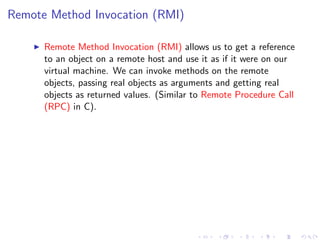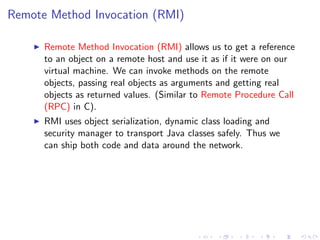Remote Method Invocation (RMI) allows Java objects to invoke methods on remote Java objects located on other hosts or machines. RMI uses stubs and skeletons as proxies to make remote calls appear local. The stubs act as local representatives for remote objects, while skeletons on the remote host receive the calls and forward them to the actual remote objects. RMI handles object serialization and deserialization to transfer objects between clients and servers.





![RMI Hello Server
--Hello.java--
public interface Hello extends java.rmi.Remote {
String sayHello() throws java.rmi.RemoteException;
}
--HelloServer.java---
import java.rmi.*;
import java.rmi.registry.*;
import java.rmi.server.UnicastRemoteObject;
public class HelloServer extends UnicastRemoteObject implements Hello
{
private String name;
private static int registryPort = 1099;
public HelloServer(String s) throws RemoteException {
super();
name = s;
}
public String sayHello() throws RemoteException {
return "Hello World!";
}
public static void main(String args[])
{
if (args.length > 0) {
registryPort = Integer.parseInt(args[0]);
}
// Create and install a security manager
System.setSecurityManager(new RMISecurityManager());
try {
Registry registry = LocateRegistry.getRegistry(registryPort);
HelloServer obj = new HelloServer("//HelloServer");
registry.rebind("HelloServer", obj);
System.out.println("HelloServer bound in registry");
} catch (Exception e) {
System.out.println("HelloServer err: " + e.getMessage());
e.printStackTrace();
}
}
}](https://image.slidesharecdn.com/java-rmi-130521060422-phpapp01/85/Java-rmi-6-320.jpg)
![RMI Hello Client
import java.rmi.registry.LocateRegistry;
import java.rmi.registry.Registry;
public class HelloClient {
private HelloClient() {}
public static void main(String[] args) {
if (args.length < 1) {
System.err.println("Usage: java HelloClient <host> [<registry-port>]");
System.exit(1);
}
String host = null;
int registryPort = 1099;
if (args.length == 1) {
host = args[0];
} else {
host = args[0];
registryPort = Integer.parseInt(args[1]);
}
try {
Registry registry = LocateRegistry.getRegistry(host, registryPort);
Hello stub = (Hello) registry.lookup("HelloServer");
String response = stub.sayHello();
System.out.println("response: " + response);
} catch (Exception e) {
System.err.println("Client exception: " + e.toString());
e.printStackTrace();
}
}
}](https://image.slidesharecdn.com/java-rmi-130521060422-phpapp01/85/Java-rmi-7-320.jpg)
![Running the RMI Hello World Example
This example is in the folder rmi-rpc/rmi/ex1-HelloServer. First we need to start up
the rmiregistry. It runs on port 1099 by default. Choose a different port if you want to
run your own copy.
rmiregistry [registryPort] &
Then we start up the server as follows:
java -Djava.security.policy=mysecurity.policy HelloServer &
Here mysecurity.policy is the security policy that is required. Now run the client as
follows:
java HelloClient hostname [registryPort]
Once you are done, kill the server and the rmiregistry as shown below.
killall -9 rmiregistry
fg <Ctrl-C>](https://image.slidesharecdn.com/java-rmi-130521060422-phpapp01/85/Java-rmi-8-320.jpg)



![Example 3: Server
import java.rmi.*;
import java.util.*;
public class MyServer
extends java.rmi.server.UnicastRemoteObject implements Server {
public MyServer() throws RemoteException { }
// Implement the Server interface
public Date getDate() throws RemoteException {
return new Date();
}
public Object execute( WorkRequest work ) throws RemoteException {
return work.execute();
}
public StringEnumeration getList() throws RemoteException {
return new StringEnumerator(
new String [] { "Foo", "Bar", "Gee" } );
}
public void asyncExecute( WorkRequest request , WorkListener listener )
throws java.rmi.RemoteException {
Object result = request.execute();
System.out.println("async req");
listener.workCompleted( request, result );
System.out.println("async complete");
}
public static void main(String args[]) {
System.setSecurityManager(new RMISecurityManager());
try {
Server server = new MyServer();
Naming.rebind("NiftyServer", server);
System.out.println("bound");
} catch (java.io.IOException e) {
System.out.println("// Problem registering server");
System.out.println(e);
}
}
}](https://image.slidesharecdn.com/java-rmi-130521060422-phpapp01/85/Java-rmi-12-320.jpg)
![Example 3: RMI Client
import java.rmi.*;
public class MyClient
extends java.rmi.server.UnicastRemoteObject implements WorkListener {
public static void main(String [] args) throws RemoteException {
System.setSecurityManager(new RMISecurityManager());
new MyClient( args[0] );
}
public MyClient(String host) throws RemoteException {
try {
Server server = (Server)Naming.lookup("rmi://"+host+"/NiftyServer");
System.out.println( server.getDate() );
System.out.println( server.execute( new MyCalculation(2)));
StringEnumeration se = server.getList();
while ( se.hasMoreItems() )
System.out.println( se.nextItem() );
server.asyncExecute( new MyCalculation(100), this );
} catch (java.io.IOException e) {
// I/O Error or bad URL
System.out.println(e);
} catch (NotBoundException e) {
// NiftyServer isn’t registered
System.out.println(e);
}
}
public void workCompleted( WorkRequest request, Object result)
throws RemoteException
{
System.out.println("Async work result = " + result);
System.out.flush();
}
}](https://image.slidesharecdn.com/java-rmi-130521060422-phpapp01/85/Java-rmi-13-320.jpg)
![Running the RMI Client-Callback Example
This example is in the folder rmi-rpc/rmi/ex3-Client-Callback. Note that the
client needs a copy of MyServer Stub.class whereas the server needs a copy of
MyCalculation.class and MyClient Stub.class.
rmiregistry [registryPort] &
Then we start up the server as follows:
java -Djava.security.policy=mysecurity.policy HelloServer &
or if running over actual internet use
java -Djava.rmi.server.codebase="http://onyx.boisestate.edu/~amit/rmi/ex3/"
-Djava.security.policy=mysecurity.policy MyServer
Here mysecurity.policy is the security policy that is required. Now run the client
as follows:
java -Djava.security.policy=mysecurity.policy MyClient hostname [registryPort]
Note that since the server calls back the client via RMI, the client also needs to
have a security policy. Once you are done, kill the server and the rmiregistry.](https://image.slidesharecdn.com/java-rmi-130521060422-phpapp01/85/Java-rmi-14-320.jpg)
![Example 4: Load classes over the network
See example in folder rmi-rpc/rmi/ex4-Load-Remote-Class.
import java.rmi.RMISecurityManager;
import java.rmi.server.RMIClassLoader;
import java.net.*;
public class LoadClient
{
public static void main(String[] args)
{
System.setSecurityManager(new RMISecurityManager());
try {
URL url = new URL(args[0]);
Class cl = RMIClassLoader.loadClass(url,"MyClient");
System.out.println(cl);
Runnable client = (Runnable)cl.newInstance();
client.run();
System.exit(0);
} catch (Exception e) {
System.out.println("Exception: " + e.getMessage());
e.printStackTrace();
}
}
}
java LoadClient
http://onyx.boisestate.edu/∼amit/codebase/rmi/ex4/](https://image.slidesharecdn.com/java-rmi-130521060422-phpapp01/85/Java-rmi-15-320.jpg)








![Example 7 contd.: Server
import ...
public class RMIThreadServerImpl extends UnicastRemoteObject implements RMIThreadServer
{
private volatile int counter = 0;
private final int MAXCOUNT = 900000;
public RMIThreadServerImpl () throws RemoteException {
super();
}
/*public synchronized void update() {*/
public void update() {
int i;
Thread p = Thread.currentThread();
System.out.println("[server] Entering critical section: " + p.getName());
for (i = 0; i < MAXCOUNT; i++)
this.counter++;
for (i = 0; i < MAXCOUNT; i++)
this.counter--;
System.out.println("[server] Leaving critical section: " + p.getName());
}
/*public synchronized int read() {*/
public int read() {
return this.counter;
}
public static void main (String[] args) {
try {
RMIThreadServerImpl localObject = new RMIThreadServerImpl( );
Naming.rebind("//localhost:5130/RMIThreadServer", localObject);
System.err.println("DEBUG: RMIThreadServerImpl RMI listener boundn");
} catch (RemoteException e) {
System.err.println("RemoteException: " + e);
} catch (MalformedURLException e) {
System.err.println("MalformedURLException: " + e);
}
}
}](https://image.slidesharecdn.com/java-rmi-130521060422-phpapp01/85/Java-rmi-24-320.jpg)
![Example 7 contd.: Client
import java.io.*;
import java.net.*;
import java.rmi.*;
public class RMIThreadClient {
/* RMI Parameters */
String host = "localhost:5130";
RMIThreadServer remObj;
public static void main (String[] args) {
RMIThreadClient myself = new RMIThreadClient();
System.exit(0);
}
/** Constructor */
public RMIThreadClient() {
try {
remObj = (RMIThreadServer) Naming.lookup("//" + host + "/RMIThreadServer");
System.out.println("[client] (before) counter = " + remObj.read() );
remObj.update();
System.out.println("[client] (after) counter = " + remObj.read() );
} catch (java.rmi.NotBoundException e) {
System.err.println("RMI endpoint not bound: "+e);
System.exit(2);
} catch (java.net.MalformedURLException e) {
System.err.println("RMI endpoint URL not formed correctly: "+e);
System.exit(2);
} catch (java.rmi.RemoteException e) {
System.err.println("RMI RemoteException: "+e);
System.exit(2);
}
}
}](https://image.slidesharecdn.com/java-rmi-130521060422-phpapp01/85/Java-rmi-25-320.jpg)


![Example 5: Asynchronous Client
public class MyClient extends java.rmi.server.UnicastRemoteObject
implements WorkListener
{
private Semaphore sem;
private static final long serialVersionUID = -6314695118464643327L;
public static void main(String [] args) throws RemoteException
{
System.setSecurityManager(new RMISecurityManager());
new MyClient(args[0]);
}
public MyClient(String host) throws RemoteException
{
sem = new Semaphore(-3);
try {
...
server.asyncExecute( new MyCalculation(10000), this );
server.asyncExecute( new MyCalculation(1000), this );
server.asyncExecute( new MyCalculation(10), this );
server.asyncExecute( new MyCalculation(50), this );
sem.Down();
System.exit(0);
} catch (...) {...}
}
public void workCompleted( WorkRequest request, Object result )
throws RemoteException
{
//.. process result
sem.Up();
}
}](https://image.slidesharecdn.com/java-rmi-130521060422-phpapp01/85/Java-rmi-28-320.jpg)

